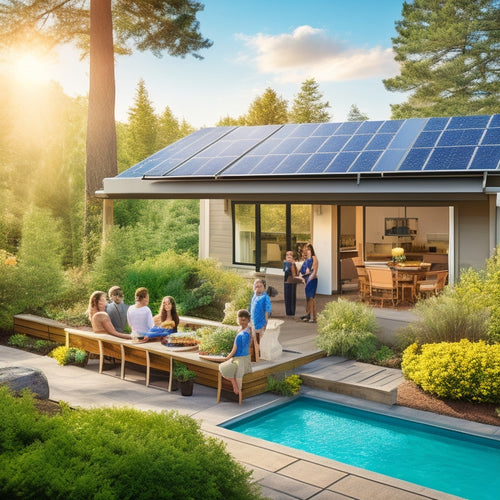
What Happens to Solar Efficiency in Heat
Share
As you deploy solar panels, high temperatures can silently erode their efficiency, with losses ranging from 0.4% to 1.0% per degree Celsius above 25°C, markedly impacting your overall energy output. This reduction in efficiency can be attributed to thermal degradation, increased internal resistance, and dust accumulation, which can lead to up to 25% energy output loss. To combat these effects, it's essential to understand the ideal operating temperature range of 15°C to 35°C and implement effective thermal management strategies. By grasping these factors, you'll reveal the key to maximizing your solar panel's performance and minimizing heat-induced inefficiencies.
Overview
- High temperatures significantly reduce solar panel efficiency, with losses ranging from 0.4% to 1.0% per degree Celsius above 25°C.
- Efficiency drops become more pronounced at higher temperatures, with a 0.4-0.5% decrease for every 1°C increase above 25°C.
- The ideal operating temperature range for solar panels is between 15°C and 35°C, with temperatures exceeding this threshold leading to increased electrical resistance and reduced performance.
- Thermal degradation causes a permanent reduction in energy conversion capabilities, while increased internal resistance within solar cells further reduces energy output.
- Effective thermal management, including cooling systems and design optimization, is crucial to mitigate heat-induced inefficiencies and maintain peak performance.
Temperature Impact on Solar Cells
Your solar panel's efficiency is considerably impacted by temperature, with high temperatures being a major culprit in reducing its performance.
As temperatures rise, solar cell materials undergo a significant reduction in efficiency. This is due to the negative temperature coefficients associated with most solar cell materials.
In fact, efficiency losses range from 0.4% to 1.0% per degree Celsius above 25°C thermal stress, with losses reaching 0.7-1.0% for each degree above 50°C.
The resulting performance degradation can be substantial, with some panels losing up to 0.5% of their efficiency for every degree Celsius increase in temperature.
Effective thermal management is vital to mitigate this effect.
Heat-Related Energy Loss Factors
As you enhance your solar panel's performance, it's essential to understand the various heat-related energy loss factors that can further exacerbate temperature-induced efficiency losses.
You'll want to take into account thermal degradation, which occurs when high temperatures cause a permanent reduction in your panel's energy conversion capabilities. This degradation can lead to a decrease in your panel's overall energy output, reducing its ability to generate power efficiently.
Additionally, heat can also impact energy conversion by increasing the internal resistance within your solar cells, further reducing their energy output. In extreme conditions, high temperatures can even lead to dust accumulation that can reduce energy output by up to 50%.
Furthermore, solar panels are also tested for resistance to abrasive sand and dust in arid environments, which is vital to maintaining peak performance.
Optimal Operating Temperature Range
When you're designing a solar thermal system, you'll want to operate within an ideal temperature range to maximize energy output. This range is bounded by a perfect temperature threshold, above which efficiency begins to decline, and heat tolerance limits, beyond which system components can be damaged.
For instance, selecting high-efficiency solar panels with heat resistance can minimize energy loss in high temperatures solar panel selection. Regular cleaning and inspection of solar panels are also essential to prevent debris from reducing energy output by up to 25%.
Ideal Temp Threshold
Operating at the perfect temperature threshold is essential for maximizing solar efficiency in heat.
You'll want to make sure your solar panels operate within the best temperature range to minimize temperature effects on solar performance.
The ideal temp threshold typically falls between 59°F (15°C) and 95°F (35°C).
Within this range, your solar panels will maintain their maximum energy output.
Exceeding this threshold can lead to reduced efficiency, as high temperatures can cause electrical resistance to increase, decreasing overall performance.
Heat Tolerance Limits
Solar panels have a heat tolerance limit, which is the ideal operating temperature range within which they can efficiently convert sunlight into electrical energy.
You should know that this limit varies depending on material properties and solar panel design. When operating within this range, heat absorption is minimal, and thermal management is most favorable.
However, environmental factors like temperature extremes can push your panels beyond their heat tolerance limits, affecting performance metrics.
Efficiency testing shows that exceeding these limits can lead to reduced energy output and even damage to the panels.
Understanding heat tolerance limits is vital for maximizing energy freedom, so it's important to take these factors into account when selecting and installing your solar panels.
Efficiency Drop in High Temps
Across a broad temperature range, photovoltaic cells exhibit a characteristic decline in efficiency, and this drop becomes particularly pronounced at high temperatures. As you consider the performance of your solar panels, it is crucial to understand the impact of heat on their efficiency.
| Temperature (°C) | Efficiency Drop (%) |
|---|---|
| 25 | 0 |
| 40 | 10 |
| 60 | 20 |
You'll notice that for every 1°C increase in temperature above 25°C, the efficiency of your solar panels drops by approximately 0.4-0.5%. This reduction in efficiency leads to solar panel degradation, emphasizing the importance of thermal energy management. By understanding this relationship, you can make informed decisions about your solar panel system, ensuring peak performance and maximum energy production.
Cooling Systems for Solar Panels
Several solar panel cooling systems have been developed to mitigate the efficiency drop caused by high temperatures.
You'll find both active and passive cooling systems being used. Active cooling involves ventilation systems and heat dissipation techniques to reduce temperatures.
Passive cooling, on the other hand, uses cooling materials, reflective coatings, and thermal management designs to minimize heat absorption.
These systems are essential for ideal performance monitoring and ensuring your solar panels operate at their best.
By implementing these cooling systems, you can prevent overheating and maintain your solar panels' efficiency, even in hot climates.
This means you'll generate more power and enjoy greater freedom from traditional energy sources.
Mitigating Heat-Induced Inefficiencies
Up to 25% of a solar panel's energy output can be lost due to high operating temperatures, making it essential to mitigate heat-induced inefficiencies. You can achieve this through effective heat management and thermal regulation.
One approach is to use passive cooling systems, such as finned heat sinks or heat pipes, which can reduce temperatures by up to 10°C. Active cooling systems, like fans or misting systems, can also be employed.
Additionally, you can optimize your solar panel's design and installation to minimize heat buildup. This includes using high-efficiency panels, increasing airflow around the panels, and orienting them to minimize direct sunlight during peak hours.
Frequently Asked Questions
Do Solar Panels Work Better in Cold Climates Than Hot Ones?
You'll find that solar panel performance is ideal in cold climates, as temperature effects reduce efficiency in hot environments, making cooler temperatures a better fit for maximizing your energy independence.
Can High Temperatures Cause Permanent Damage to Solar Panels?
You're wondering if scorching temperatures will turn your solar panels into useless bricks, right? Well, high temps can cause thermal degradation, leading to permanent efficiency loss, but don't freak out - most modern panels are designed to withstand the heat.
How Often Should I Clean My Solar Panels to Reduce Heat Buildup?
You should clean your solar panels every 6-12 months to mitigate dust accumulation, as infrequent cleaning can lead to reduced energy output; consider more frequent cleaning in arid regions to optimize energy production.
Are There Solar Panels Specifically Designed for Hot Desert Climates?
As you traverse the scorching dunes, you'll find desert solar panels customized to your needs, boasting heat resistance to minimize thermal losses, ensuring you utilize the desert's intense sunlight with precision and freedom.
Can I Use a Misting System to Cool My Solar Panels?
You can implement a misting system to cool your solar panels, leveraging misting technology to enhance panel performance by up to 10%, as water evaporates, reducing temperatures and increasing energy output.
Ready to Buy
As you wield the power of the sun, remember that heat can be a silent thief, stealing away your solar panel's efficiency. Like a skilled thief in the night, high temperatures can sneak up on you, reducing your energy output by as much as 0.5% per degree Celsius above 25°C. Don't let heat get the best of you - optimize your system's operating temperature and consider cooling solutions to keep your solar panels running at their best.
Related Posts
-

How to Achieve a Zero-Waste Lifestyle for a Greener Tomorrow
To achieve a zero-waste lifestyle, start by adopting the principles of refusing, reducing, reusing, and recycling. Sw...
-

Top-Rated Home Solar Power Kits for Achieving Energy Independence
Top-rated home solar power kits enable you to achieve energy independence by greatly cutting your energy costs. You c...
-

Designing a Green Roof for Maximum Energy Efficiency
Designing a green roof for maximum energy efficiency involves several key strategies. Start by selecting native, drou...


